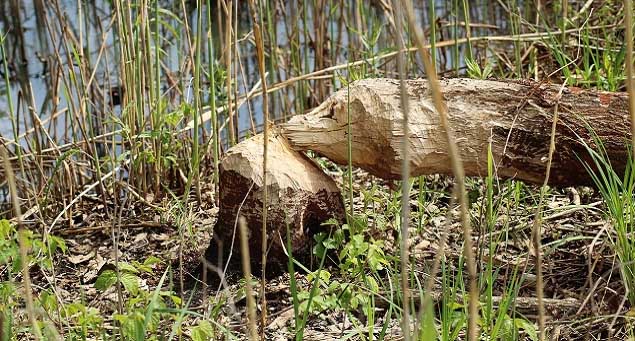Today we welcome a guest post from Dylan Walker of Wilderlife to tell us about the return of Beavers to The Living Coast...
A dam fine idea
On 10th January 2020 Natural England granted a licence to release beavers into an enclosed area at Knepp Estate, West Sussex, less than 10 miles as the crow flies from The Living Coast biosphere reserve encompassing Brighton and Lewes. One of a number of beaver licenses granted in England for similar introductions so far this year, the move should result in beavers returning to the wild in Sussex and other English counties after an absence of around 500 years!

Beavers used to be widespread in England, Wales and Scotland but hunting for their fur, meat and 'castoreum', a secretion used in perfumes, food and medicine, led to their extinction by the 16th Century. Losing beavers was bad news for so much of our native wildlife across our forests and wetlands. That's because beavers have a positive effect on their environment through their behaviour. By gnawing on trunks and branches they 'coppice' trees like willow, hazel, rowan and aspen, cutting them almost to the ground. The regrowth creates denser vegetation and provides homes for a variety of insects and birds.
Counter-intuitive? Wetlands that reduce flooding
Beavers are also beneficial because of their incredible anti-flooding activities! The wetlands which beavers create by building small dams in streams slow down water flow and reduce the risk of flooding on floodplains. Their skills have never been more needed at a time when extreme weather due to climate change is putting more of our houses at risk than ever before. Beavers are one solution to a problem that we have taken the wrong approach to for too many years.
For centuries now we have invested huge financial resources in clearing drains, ditches, streams, and rivers so that they can drain as quickly as possible. Our strategy has been: “Get rid of the water fast and we will prevent the flood!”. Now, taking advice from the way of the beaver, we are realising that we should have been doing the complete opposite! By slowing down water movement across our water catchments we dramatically reduce the risk of flooding and give time for our rivers to release water during heavy rainfall. A study in the United States, for example, showed that river water took under four hours to travel 2.6 kilometres where there were no beaver dams, compared to 11 days(!) when a single, leaky, 1.5m high beaver dam was established!
The busy building beavers also create wetland habitats that are valuable for many other animals, including otters, water voles, water shrews and wildfowl. Craneflies, water beetles and dragonflies in turn support breeding fish and insect-eating birds like spotted flycatchers and yellow wagtails. Slowing watercourses also allows pollutants to sink out of the water column and become locked up in sediments, further cleaning and protecting our rivers and seas!

Before beavers there were Leaky dams!
Although we might not be spotting beavers in The Living Coast in the very near future, people across the biosphere reserve have already been preparing to welcome them by doing a little bit of beavering themselves! One simple and cool way to reduce flood risk and create wildlife habitat is to make a ‘leaky dam’ where there is flowing water. Leaky dams occur naturally when large sections of trees fall into, and across a water channel, holding back water during high flows. By building ‘Leaky Dams’, we can replicate these processes (and the processes of beavers) by using a variety of different methods that utilise locally sourced wood, securely pinned in place. Note that budding dam builders should check with their local authority or the Environment Agency for consent depending on the size of the watercourse.
Live streaming
It’s exciting to think that The Living Coast may soon be welcoming back these wonderful aquatic mammals, and that in the meantime we are beavering around making our biosphere reserve a bit wetter in order to help nature and keep our own houses drier! If you’d like to learn why it’s important to cut down trees like a beaver, watch my video tutorial here. Information on how to build a leaky dam can be found here! Look out for leaky dams when walking through the River Ouse catchment, as several have been constructed as part of the Sussex Flow Initiative.
Dylan Walker is the founder of Wilderlife, an organisation that helps people to connect with nature by learning simple techniques for rewilding the places they live and the food they eat. An ecologist and marine scientist, Dylan travelled from pole to pole in search of wilderness before realising that the juiciest stuff was at home in the Living Coast. He specializes in running courses, workshops and events that empower businesses and citizens to love and protect their unique natural heritage through fun rewilding activities.
For more information go to: wilderlife.org
Related
Comments
Nobody has commented on this post yet, why not send us your thoughts and be the first?


 to add an item to your Itinerary basket.
to add an item to your Itinerary basket.







